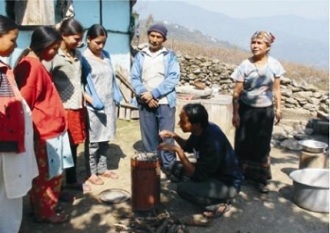June 16, 2011 – In September 2010, U.S. Secretary of State Clinton announced the Global Alliance for Clean Cookstoves, a public-private partnership led by the United Nations Foundation to save lives, improve livelihoods, empower women, and combat climate change by creating a thriving global market for clean and efficient household cooking solutions. The Alliance’s 100 by 20 goal calls for 100 million homes to adopt clean and efficient stoves and fuels by 2020.
On the heels of Secretary Clinton’s visit to Africa this week, seven African nations have joined the Alliance, including Burkina Faso, Ethiopia, Kenya, Lesotho, Rwanda, and Tanzania as well as the Nigerian Alliance for Clean Cookstoves, which includes four Nigerian federal ministries.
The Problem: Nearly half of the world’s population – about 3 billion people – cooks their food each day on polluting, inefficient stoves. Exposure to smoke from traditional cookstoves and open fires is the fifth worst health risk factor in poor countries and leads to nearly 2 million premature deaths of mostly women and young children each year (more than twice the mortality from malaria).
More than 70% of Africans burn solid fuels such as wood, charcoal or crop residues for their home cooking needs. The World Health Organization (WHO) estimates that each year more than one quarter of the worldwide deaths associated with exposure to cookstove smoke occur in Africa – that equates to more than 550,000 deaths in Africa attributable to cookstoves. Also according to WHO, out of the 23 countries in the world where cookstoves represent more than 4 percent of the national burden of disease*, 21 are in Africa.
A Global Alliance: The Global Alliance for Clean Cookstoves (Cleancookstoves.org) is working with public, private, and non-profit partners to help overcome market barriers and achieve large-scale production, deployment, and use of clean stoves and fuels in the developing world. The Alliance comprises a rapidly growing list of nearly 100 public, private, philanthropic, NGO, academic, and other partners, including the governments of Norway, Denmark, El Salvador, Finland, Germany, Ireland, Malta, Peru, and the United Kingdom. The Ethiopian Government has an ambitious national effort to address the risks associated with cookstoves, and many leading partners of this sector are active in Ethiopia, including: UNHCR, Deutsche Gesellschaft für Internationale Zusammenarbeit (GIZ), the Netherlands Development Organisation (SNV), Project Gaia, and Bosch-Siemens. World Vision is piloting other improved stoves in Ethiopia.
U.S. Government Commitment: The United States Government has committed more than $50 million to the Alliance over five years. Participating U.S. agencies include: The State Department, Environmental Protection Agency, Department of Energy, Department of Health and Human Services (National Institutes of Health; Centers for Disease Control and Prevention), and the U.S. Agency for International Development. The U.S. Government is mobilizing financial resources, providing top-level U.S. experts, and leveraging research and development tools to help the Alliance achieve its 100 by 20 target. Other U.S. agencies also are considering investments in this sector.



